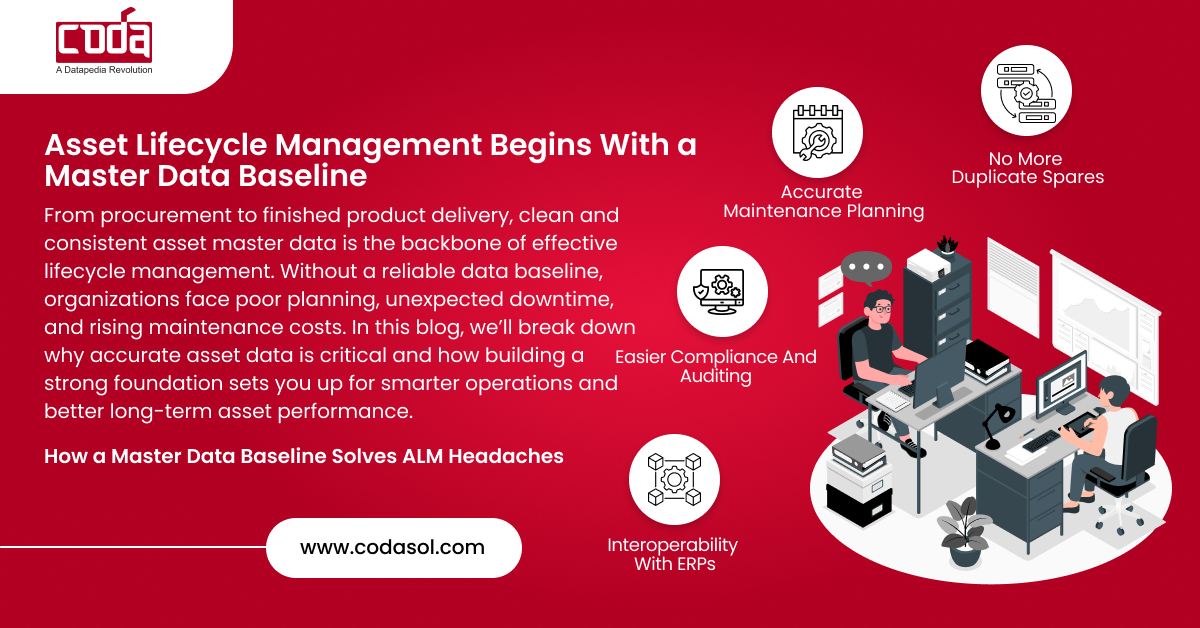When Asset Data Fails, Everything Follows
You can have the best ERP system. The most skilled maintenance team. Even the latest IoT sensors feeding you real-time data.
But if your asset master data is wrong, or worse, inconsistent, none of it works the way it should.
Broken pumps get misdiagnosed. Spares are ordered twice. Compliance reports don’t match reality. And somewhere in the process, time and money disappear quietly, but steadily.
This isn’t a system issue. It’s a data issue. And the fix starts with a master data baseline.
In asset-intensive sectors like Oil & Gas, Utilities, Construction, and Manufacturing, the cost of bad data isn’t theoretical. It’s happening daily through delayed projects, emergency maintenance, redundant purchases, and failed audits. All because there’s no single, trusted source of truth for asset information.
What Is a Master Data Baseline?
A master data baseline is your single source of truth for all critical asset information like names, specifications, classifications, locations, conditions, and relationships. It’s the foundation of every asset decision across planning, procurement, operations, and maintenance.
Think of it like trying to build a skyscraper on sand. That’s what running asset lifecycle management (ALM) without a solid data baseline feels like.
Why It’s the First Step in Asset Lifecycle Management
Every phase of an asset’s life, from design to disposal, depends on accurate master data:
| Lifecycle Stage | What Depends on Good Data? |
|---|---|
| Planning | Budgeting, design validation, asset specification |
| Procurement | Correct vendor selection, no duplicate orders |
| Installation | Right materials at the right place, compliance tracking |
| Operations | Inventory control, spare part traceability, performance monitoring |
| Maintenance | Preventive schedules, criticality ranking, MRO strategy |
| Decommissioning | Environmental compliance, residual value assessment |
Without a clean baseline, these stages become guesswork, and that’s expensive.
Case study: Gulf Refinery’s $2.5M Mistake
A leading refinery in the GCC ordered 500 valves, only to discover 300 were already lying unused in another warehouse under a different naming convention. The root cause? No unified asset master data.
Post-baseline cleanup with an MDM solution saved them millions by:
- Consolidating duplicate records
- Standardizing naming across plants
- Linking BOMs, inventory, and ERP systems
How a Master Data Baseline Solves ALM Headaches
Here’s how establishing a clean, governed master data foundation transforms your asset lifecycle:
1. No More Duplicate Spares
Say goodbye to stockpiling the same part under ten different names. A baseline merges and deduplicates.
2. Accurate Maintenance Planning
When asset hierarchies and conditions are clearly defined, PMs and CMs get smarter—and cheaper.
3. Easier Compliance and Auditing
Clean data makes it simple to prove compliance with ISO 55000, OSHA, or regional safety norms.
4. Interoperability with ERPs
Your SAP, Oracle, or Maximo will finally “speak the same language” across departments and geographies.
Signs Your Business Needs a Master Data Baseline Now
- You find multiple entries for the same asset in your ERP
- Maintenance teams often complain about wrong spares
- Procurement keeps reordering unused parts
- Physical stock doesn’t match digital records
- You’ve failed compliance audits due to data issues
If you checked more than two boxes, it’s time.
Ready to Clean Up Your Data?
Let our team of data engineers assess your asset data quality.
How to Build a Master Data Baseline: A Step-by-Step Guide
- Asset Data Discovery
- Audit current data across all plants and systems
- Standardization
- Apply ISO-compliant templates (like UNSPSC, eCl@ss, or internal taxonomy)
- Deduplication & Enrichment
- Merge records, fill gaps, add specifications
- Codification
- Assign structured material codes linked to classification standards
- Integration with ERP & EAM
- Align master data with SAP, Oracle, Maximo, etc.
- Governance Layer
- Set up controls, workflows, and AI/ML-powered validations
Choosing the Right MDM Partner: What to Look For
- Industry expertise in asset-intensive operations
- AI/ML capabilities for smart deduplication and classification
- Global taxonomy knowledge for compliance
- ERP/EAM integration experience
- Proven frameworks for multi-site rollouts
Use Case: Indian EPC Giant Saves ₹9 Cr. in 8 Months
One of India’s top Engineering & Construction firms tackled duplicate material codes across their five projects. After implementing a structured MDM program, they:
- Reduced procurement cost by 12%
- Cut lead time on spares by 40%
- Enabled predictive maintenance via accurate BOMs
Start your master data journey with our AI-powered MDM platform.
Frequently Asked Questions
1. What is a master data baseline?
A master data baseline is a standardized, validated foundation of key asset information used to support lifecycle management, operations, and compliance.
2. Why is it important for asset lifecycle management?
It ensures consistency, avoids duplication, supports maintenance planning, enables compliance, and enhances decision-making across asset-related functions.
3. How long does it take to establish a baseline?
Depending on the size and complexity of your operations, initial baselining can take from 2 to 6 months with the right tools and expertise.
4. Can AI/ML help in creating the master data baseline?
Yes, AI and machine learning can automatically detect duplicates, fill missing attributes, and suggest classification patterns, speeding up the process.
5. Which industries benefit most from a master data baseline?
Industries with high asset counts like Oil & Gas, EPC, Utilities, Ports, Manufacturing, and Healthcare benefit significantly due to the complexity and cost associated with assets.
6. Does a master data baseline help in digital transformation?
Absolutely. Clean, structured data is the foundation for automation, digital twins, predictive maintenance, and enterprise-wide analytics.

